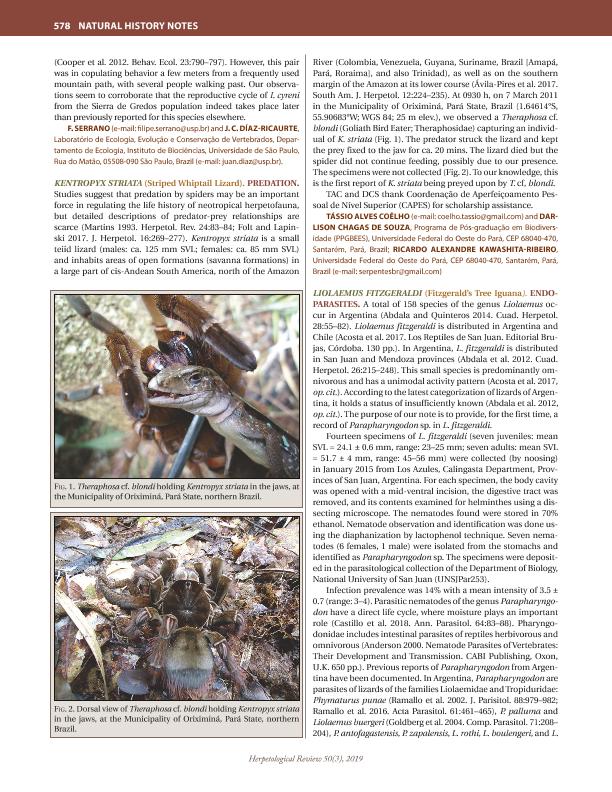Mostrar el registro sencillo del ítem
dc.contributor.author
Castillo, Gabriel Natalio

dc.contributor.author
Acosta, Juan Carlos

dc.contributor.author
Acosta, Rodrigo

dc.date.available
2022-04-22T20:00:22Z
dc.date.issued
2019-09
dc.identifier.citation
Castillo, Gabriel Natalio; Acosta, Juan Carlos; Acosta, Rodrigo; Liolaemus fitzgeraldi (Fitzgerald’s Tree Iguana): Endoparasites; Society for the Study of Amphibians and Reptiles; Herpetological Review; 50; 3; 9-2019; 578-579
dc.identifier.issn
0018-084X
dc.identifier.uri
http://hdl.handle.net/11336/155628
dc.description.abstract
A total of 158 species of the genus Liolaemus occur in Argentina (Abdala and Quinteros 2014. Cuad. Herpetol. 28:55–82). Liolaemus fitzgeraldi is distributed in Argentina and Chile (Acosta et al. 2017. Los Reptiles de San Juan. Editorial Brujas, Córdoba. 130 pp.). In Argentina, L. fitzgeraldi is distributed in San Juan and Mendoza provinces (Abdala et al. 2012. Cuad. Herpetol. 26:215–248). This small species is predominantly omnivorous and has a unimodal activity pattern (Acosta et al. 2017, op. cit.). According to the latest categorization of lizards of Argentina, it holds a status of insufficiently known (Abdala et al. 2012, op. cit.). The purpose of our note is to provide, for the first time, a record of Parapharyngodon sp. in L. fitzgeraldi. Fourteen specimens of L. fitzgeraldi (seven juveniles: mean SVL = 24.1 ± 0.6 mm, range: 23–25 mm; seven adults: mean SVL = 51.7 ± 4 mm, range: 45–56 mm) were collected (by noosing) in January 2015 from Los Azules, Calingasta Department, Provinces of San Juan, Argentina. For each specimen, the body cavity was opened with a mid-ventral incision, the digestive tract was removed, and its contents examined for helminthes using a dissecting microscope. The nematodes found were stored in 70% ethanol. Nematode observation and identification was done using the diaphanization by lactophenol technique. Seven nematodes (6 females, 1 male) were isolated from the stomachs and identified as Parapharyngodon sp. The specimens were deposited in the parasitological collection of the Department of Biology, National University of San Juan (UNSJPar253). Infection prevalence was 14% with a mean intensity of 3.5 ± 0.7 (range: 3–4). Parasitic nematodes of the genus Parapharyngodon have a direct life cycle, where moisture plays an important role (Castillo et al. 2018. Ann. Parasitol. 64:83–88). Pharyngodonidae includes intestinal parasites of reptiles herbivorous and omnivorous (Anderson 2000. Nematode Parasites of Vertebrates: Their Development and Transmission. CABI Publishing, Oxon, U.K. 650 pp.). Previous reports of Parapharyngodon from Argentina have been documented. In Argentina, Parapharyngodon are parasites of lizards of the families Liolaemidae and Tropiduridae: Phymaturus punae (Ramallo et al. 2002. J. Parisitol. 88:979–982; Ramallo et al. 2016. Acta Parasitol. 61:461–465), P. palluma and Liolaemus buergeri (Goldberg et al. 2004. Comp. Parasitol. 71:208– 204), P. antofagastensis, P. zapalensis, L. rothi, L. boulengeri, and L. umbrifer (O’Grady and Dearing 2006. Oecologia 150:355–361), P. williamsi (Ramallo et al. 2016. Acta Parasitol. 61:461–465), P. extrilidus (Ramallo et al. 2017. Herpetol. Rev. 48:198; Castillo et al. 2018. Ann. Parasitol. 64:83–88), L. ruibali (Castillo et al. 2017. Herpetol. Rev. 48:651–652), Tropidurus torquatus (Lamas and Zaracho 2006. Herpetol. Rev. 37:4), and T. etheridgei (Cruz et al. 1998. Herpetol. Nat. Hist. 6:23–21).
dc.format
application/pdf
dc.language.iso
eng
dc.publisher
Society for the Study of Amphibians and Reptiles

dc.rights
info:eu-repo/semantics/openAccess
dc.rights.uri
https://creativecommons.org/licenses/by-nc-sa/2.5/ar/
dc.subject
LIOLAEMUS FITZGERALDI
dc.subject
ENDOPARASITES
dc.subject
Parapharyngodon sp.
dc.subject
San Juan
dc.subject.classification
Zoología, Ornitología, Entomología, Etología

dc.subject.classification
Ciencias Biológicas

dc.subject.classification
CIENCIAS NATURALES Y EXACTAS

dc.title
Liolaemus fitzgeraldi (Fitzgerald’s Tree Iguana): Endoparasites
dc.type
info:eu-repo/semantics/article
dc.type
info:ar-repo/semantics/artículo
dc.type
info:eu-repo/semantics/publishedVersion
dc.date.updated
2022-04-20T14:39:26Z
dc.identifier.eissn
0018-084X
dc.journal.volume
50
dc.journal.number
3
dc.journal.pagination
578-579
dc.journal.pais
Estados Unidos

dc.journal.ciudad
Kansas
dc.description.fil
Fil: Castillo, Gabriel Natalio. Universidad Nacional de San Juan. Facultad de Ciencias Exactas Físicas y Naturales. Departamento de Biología; Argentina. Consejo Nacional de Investigaciones Científicas y Técnicas. Centro Científico Tecnológico Conicet - San Juan; Argentina
dc.description.fil
Fil: Acosta, Juan Carlos. Universidad Nacional de San Juan. Facultad de Ciencias Exactas Físicas y Naturales. Departamento de Biología; Argentina
dc.description.fil
Fil: Acosta, Rodrigo. Universidad Nacional de San Juan. Facultad de Ciencias Exactas Físicas y Naturales. Departamento de Biología; Argentina
dc.journal.title
Herpetological Review

dc.relation.alternativeid
info:eu-repo/semantics/altIdentifier/url/https://ssarherps.org/herpetological-review-pdfs/
Archivos asociados
